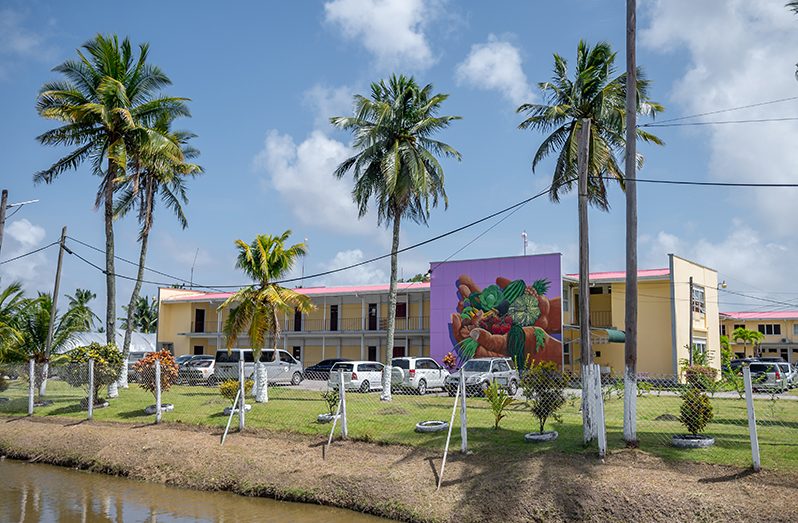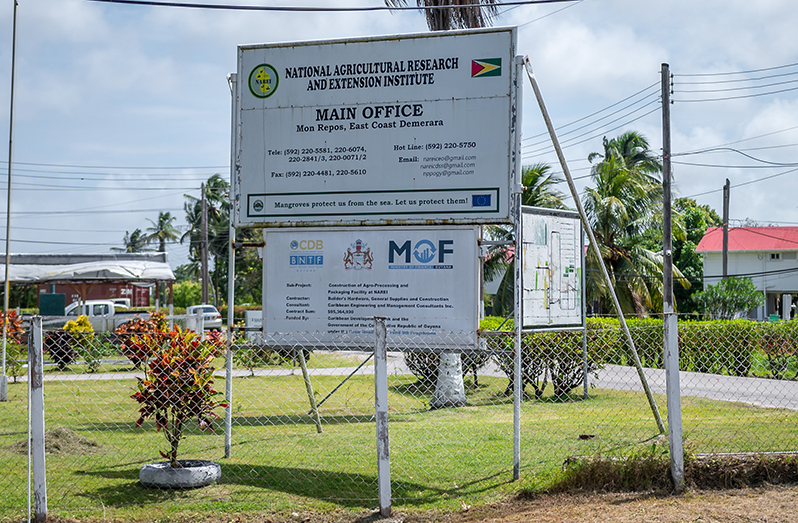The evolution through the years
ANOTHER one of Guyana’s most important educational institutions is found in the village of Mon Repos on the East Coast of Demerara, a stone’s throw away from the Guyana School of Agriculture (GSA).
According to the Parliament Act, the National Agricultural Research Institute (NARI), as it was known at the time, was formed in 1984, but the institution came into being in 1985. After some decades, the establishment evolved and the Ministry of Agriculture brought in the extension arm under the 2010 Act. NARI was later renamed the National Agricultural Research and Extension Institute (NAREI).
The head of research at NAREI, David Fredricks, explained that in those days with NARI, there was a wider spread of responsibilities that focused on the traditional crops, rice and sugar and the non-traditional crops, which included all the other crops such as ochroes, bora, pumpkins and everything else.
Under NARI, there was also a “livestock arm” and the institution was also offering laboratory services, assisting in the analysis of sugar, and doing some of the quality assurance by checking via the lab to ensure that the same methods were used and that the results were the same every time.
There were also several stations at the time, and the institution was referred to as the Mon Repos Field Research Unit (MRFRU), where the labs were located and people looked at most of the other crops. The Guyana Rice Development Board (GRDB), presently located in Burma, Mahaicony, was once the NARI Coastal Plain Field Research Unit (CPFRU) and they were looking primarily at rice. Over the years, GRDB has evolved into an entity of its own.
There is also an operation of NARI that was referred to as the Intermediate Savannahs Field Research Unit (ISFRU). This research station is located at Ebini, in Region 10, along the Berbice River. With a sandy type of terrain, the centre was focused on crops that were more suited for that environment, such as red peas, blackeyes, corn, soya beans, cotton, etc. The Minister of Agriculture, the Honourable Zulfikar Mustapha, visited the location in 2021 and signalled his government’s intention of resuscitating the station so as to improve the agricultural sector and better serve the farming community in that area by giving them the technical support that is needed.
Evolution of NAREI
With the evolution of those three units, NAREI now has a presence in all 10 administrative regions of Guyana, ensuring that there is an oversight for the farmers within the communities and gives them technical services in terms of issues that they are facing. Farmers who have problems with Acoushi ants, for example, are given assistance to control them. Soil testing is done for farmers, and the results and recommendations are given to them to better their lives in the agricultural field.
Fredericks explained that he began working at NAREI in 1986 when few people had PHDs and Master degrees.He said that the institution has evolved tremendously and went through a transition period from having technicians that were operating as heads of departments — which he credited for doing a “fairly” good job at the time — to an institution that is equipped with the proper qualified personnel in the respective fields.
He also noted that there was a programme in place that systematically allows you to study for your Master’s or PhD while working at the institution. “In almost every department and sector of NAREI right now, you have people with their PHDs and Masters and that was the basis of the evolution of where NAREI is right now,” said Fredricks.
NAREI was the first institution to have imported mangrove trees in Guyana. Mangrove is a crop, and there is a department that is looking at the mangrove tree, which is a “soft sea defence” that is a very active, productive and beneficial plant for the country that protects the people and the coastline farmers.
Apart from normal traditional crops, Fredericks mentioned that NAREI, with the government’s support, is looking to diversify and “scale up” other crops such as strawberries, blueberries, grapes, and onions. NAREI’s goal is to get it out to the farmers and have them produce acres of crops, so that the government can cut down on the import supply.
The roses are one of NAREI’s most popular crops at the moment and this was an initiative that was introduced by the President of Guyana, Dr Mohamed Irfaan Ali. The president aims to introduce rose-planting to single mothers across Guyana, so that they can earn incomes for themselves.
NAREI has developed technologies that can make the soil classified as non-agricultural land fertile now by adding biochar (charcoal) as an input to the sandy soil, which will allow the soil to maintain moisture and nutrients so that the crop can benefit from it.
According to Fredericks, many farmers have used their recommendations to plant and harvest their produce successfully. Regarding the legume farmers, NAREI also caters to them and hopes to encourage more farmers to invest in legume farming.
The nursery systems of NAREI are located in every region of Guyana and they produce plants that farmers can go and get at an affordable price.

When it comes to preservation, NAREI continues to evolve in tissue culture by investigating germplasm conservation and having their germplasm stored in vitro in solution within the facility.The idea is to conserve the plants they have, regenerating them for use by the farmers and keeping them in store in the field and in the laboratory, germplasm plants. In the case of something going wrong the institution can resupply farmers.
NAREI continues to promote greater efficiency in the crops and agricultural products industry, providing enhanced services in agricultural research, extension, and crop protection, thereby allowing effective administrative administration and regulation of trade, commerce and export of crops and agricultural produce.
The institution’s vision is to ensure food security, the empowerment of farming communities, and the enhancement of their livelihoods through improved and environmentally friendly technologies. It is also their goal to become a centre of prominence in agricultural research and development through appropriate technological development and dissemination, commercialization of research results and support services excellence to support the development of a competitive agricultural sector in Guyana.

MISSION STATEMENT
NAREI’s mission statement is to advise, develop and transfer appropriate systems to promote balanced, diversified and sustained agricultural production through adaptive and investigative research, using a market-driven approach and a range of regulatory services to the sector.



.jpg)













